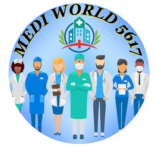HOW TO BE A CARDIAC DOCTOR
Becoming a cardiac doctor, or a cardiologist, requires a significant amount of education, training, and experience. Below are the typical steps involved in becoming a cardiologist:
1. Earn a Bachelor’s Degree (4 years)
- Prerequisite Courses: You’ll need to complete a bachelor’s degree, typically in a science-related field (such as biology, chemistry, or health sciences), with a focus on courses like biology, chemistry, physics, and mathematics. These courses prepare you for medical school.
- GPA and Extracurriculars: A high GPA is essential, along with extracurricular activities that demonstrate leadership, volunteer work, and an interest in medicine (e.g., shadowing doctors or working in healthcare settings).
2. Pass the Medical College Admission Test (MCAT)
- Preparation: After completing your undergraduate degree, you must take the MCAT, a standardized exam required for admission to medical schools. The MCAT assesses your knowledge in areas such as biology, chemistry, physics, and critical reasoning skills.
- Score: High scores on the MCAT increase your chances of being accepted into a reputable medical school.
3. Complete Medical School (4 years)
- Degree: Medical school typically takes 4 years to complete and awards an M.D. (Doctor of Medicine) or D.O. (Doctor of Osteopathic Medicine).
- Curriculum:
- The first two years primarily consist of classroom-based learning, focusing on foundational medical sciences such as anatomy, physiology, biochemistry, pharmacology, and pathology.
- The final two years are clinical rotations, where you gain hands-on experience in various medical specialties, including cardiology. You’ll also begin to learn how to interact with patients and work in different healthcare settings.
4. Complete a Residency Program in Internal Medicine (3 years)
- Internist Focus: After earning your M.D. or D.O. degree, you’ll need to complete a residency program in internal medicine, which typically lasts 3 years. During this time, you will receive extensive training in diagnosing and treating various medical conditions, including heart diseases.
- Training: You’ll work directly with patients under the supervision of experienced doctors, learning how to manage acute and chronic illnesses.
5. Complete a Fellowship in Cardiology (3-4 years)
- Subspecialization: After completing your internal medicine residency, you must enter a cardiology fellowship. This program typically lasts 3 to 4 years and focuses specifically on heart-related conditions, procedures, and treatments.
- Training: You’ll learn specialized skills in diagnosing and treating heart diseases, including coronary artery disease, heart failure, arrhythmias, and valvular heart conditions. You’ll also learn how to perform procedures like catheterizations, angioplasty, stenting, and echocardiography.
6. Obtain Board Certification in Cardiology
- Certification Exam: After completing your fellowship, you will need to pass a board certification exam in cardiology (administered by the American Board of Internal Medicine, for example). This exam assesses your knowledge, clinical skills, and ability to provide high-quality care to patients with heart conditions.
- Specialization Options: If you want to focus on a specific area of cardiology (e.g., interventional cardiology, electrophysiology, pediatric cardiology, or heart failure), you can pursue additional training through further fellowships.
7. Maintain Licensure and Continuing Education
- State Medical License: You must be licensed to practice medicine in the state or country where you work. To obtain a medical license, you will need to pass exams and meet continuing education requirements.
- Continuous Learning: Cardiologists must engage in continuing medical education (CME) to stay updated with the latest research, treatments, and technologies in cardiology. Some cardiologists also participate in specialized training or research to keep advancing their expertise.
Optional: Subspecialize in a Specific Area of Cardiology
- If you wish to focus on a subfield within cardiology, such as interventional cardiology, electrophysiology, or pediatric cardiology, you can undergo additional fellowship training (1–2 years).
Summary of Timeframe
- Bachelor’s Degree: 4 years
- Medical School: 4 years
- Residency in Internal Medicine: 3 years
- Fellowship in Cardiology: 3–4 years
- Total Time: Approximately 14-15 years of education and training to become a cardiologist.
Becoming a cardiac doctor (cardiologist) is a long but rewarding process, involving years of rigorous training and education. However, it provides an opportunity to specialize in a field that significantly impacts patients’ health and well-being.
